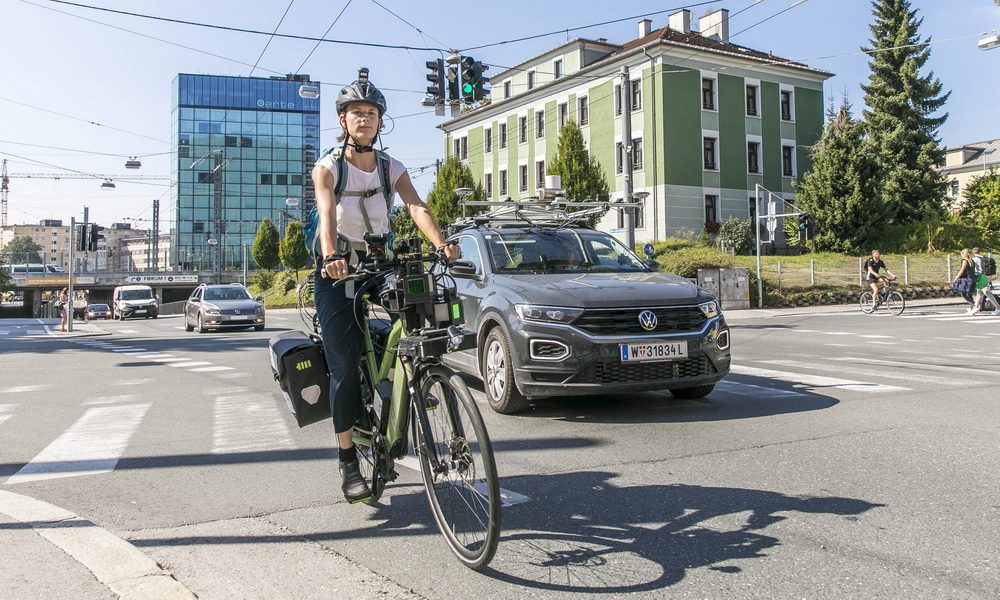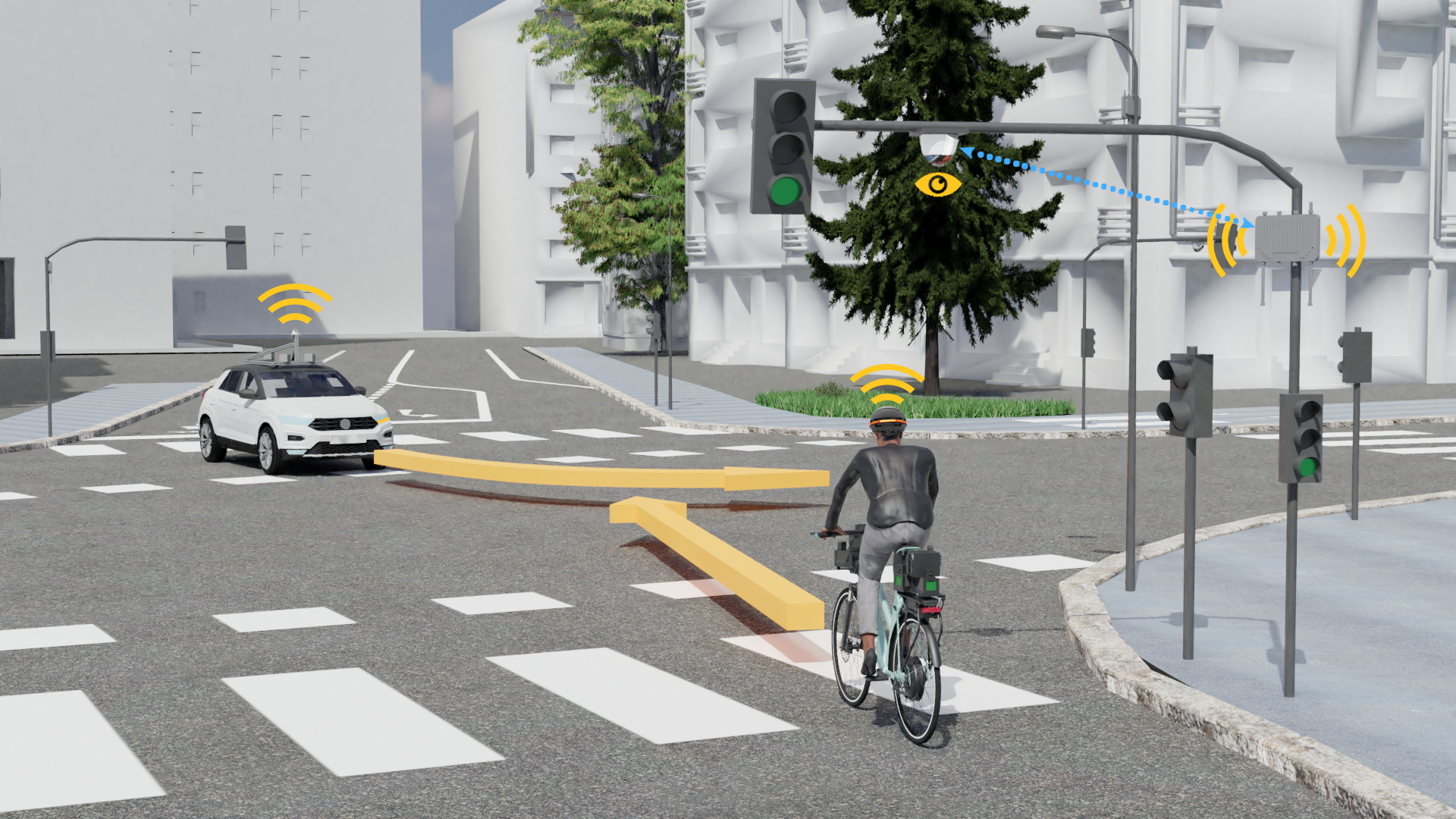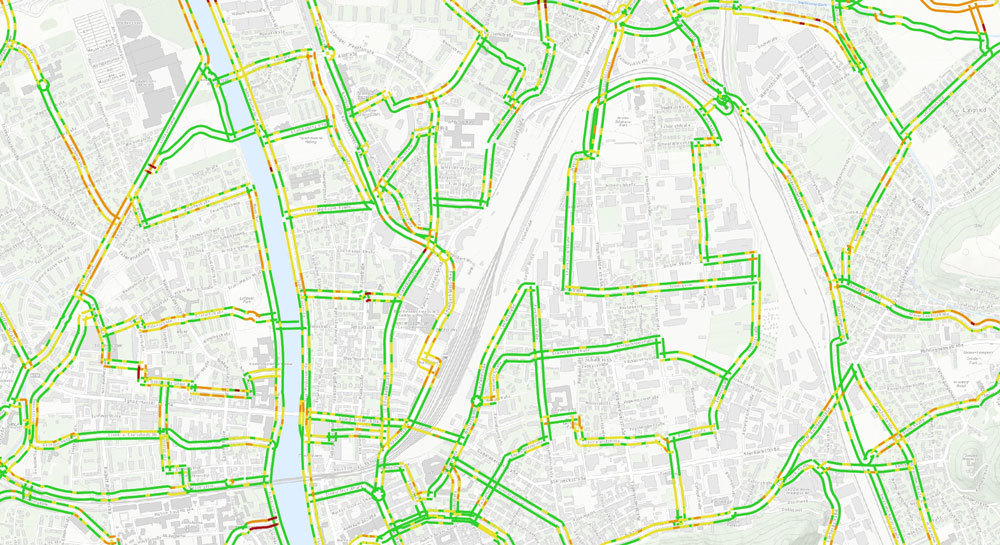
Fewer Collisions with Cyclists through Cooperative Intelligent Transport Systems
Networking and automation of vehicles offer a great opportunity to also increase the safety of cyclists. Salzburg Research, together with the Bike2CAV consortium, has for the first time validated wireless communication channels between different vehicles, bicycles and the infrastructure under real conditions, tested a method for cooperative detection of collision risks and developed warning concepts for cyclists.
Mit dem Klick auf das Bild werden durch den mit uns gemeinsam Verantwortlichen Youtube (Google Ireland Limited) das Video abgespielt, auf Ihrem PC Skripte geladen sowie personenbezogene Daten erfasst.
Road accidents involving bicycles have been steadily increasing for years. In 2015, the road accident statistics of Statistics Austria recorded 6,901 road accidents with bicycles, in 2021 it was already 9,578. The number of cyclists killed in this period fluctuated from 32 to 50 people per year. The accidents with other vehicles involved mostly occurred in a turning situation in an intersection, with the bicycle predominantly going straight ahead.
“In addition, there are a large number of near-accidents that do not appear in any accident statistics. That’s why we wanted to make these risks easier to assess with our research work, so that measures can be taken even before something happens,” says project manager Cornelia Zankl from Salzburg Research.
Technology helps reduce collision risks
The latest technological developments in the field of vehicle communication by means of ITS-G5, bicycle localisation, environment perception of the connected and automated vehicle by means of cameras and LiDAR sensors as well as roadside sensors with cameras created the basis for cooperative solution approaches for the detection and avoidance of collision risks. Vulnerable road users such as cyclists should not only be detected, but actively involved in collision avoidance.
This brings added value on several levels: Cyclists are warned of collisions at an early stage in order to recognise dangerous situations and avoid accidents. Networked vehicles and driver assistance systems can detect cyclists more reliably through improved detection quality as well as active communication and can react at an early stage. Municipalities and infrastructure operators receive objective assessments of risk zones at traffic intersections and can mitigate them preventively through targeted measures.
Real-life testing in the city and in the countryside
In the research project, different solution approaches were analysed in order to be able to select suitable and safe methods. The most promising methods were tested in a controlled experiment and tried out in three scenarios at two test intersections in rural and urban areas.


The experiments at the test intersections Weiserstraße/Gabelsbergerstraße in the city of Salzburg and at the B158 in the Salzburg municipality of Koppl, which were equipped with smart sensor technology, involved the use of a networked, automated vehicle as well as a novel networked research bicycle. A continuous chain of different data processing methods was tested, from the self-localisation and detection of road users, through the detection of collision risks and the generation and transmission of warning messages, to communication with cyclists and other road users.


Central research results
The Bike2CAV research project has impressively demonstrated the high complexity of the technical implementation of cooperative systems, as a large number of system components have to interact in a coordinated manner. The following central results were achieved in the defined focus areas of the project:
- Risk zones for cyclists at traffic junctions:
The researchers succeeded in a semi-automated derivation of interaction zones in intersection areas based on statistical accident probabilities. An important finding was that cyclists often use the infrastructure at the studied urban intersection differently than intended. This is probably due to the fact that the planning primarily follows the needs of motor vehicle traffic. - Smart bikes and self-localisation from the cyclist’s point of view:
Highly accurate self-localisation of cyclists is central to reliable detection of collision risks. In addition to two GNSS receivers installed in the Holoscene Bike, the accuracy of a smartphone and that of a helmet-mounted high-precision sensor were also investigated. The goal was a deviation of less than 50 cm with 99.9 percent reliability. Especially in an urban environment, the targeted localisation accuracy was very challenging due to dense development and a railway subway. A lateral deviation of 0.5 metres at 95 per cent reliability in a rural environment and less than two metres lateral deviation at 95 per cent reliability in an urban environment were achieved. - V2X communication for bicycles:
The approach of equipping bicycles with V2X technology in order to enable automated vehicles to perform active recognition via ITS-G5 in addition to passive recognition via environmental sensors has proven to be effective. Such bicycles are not yet available on the market, but a proof-of-concept prototype could be tested in the project. - Detection of cyclists by the infrastructure and V2X communication
Using extensive sensor technology, cyclists are to be visually detected and tracked by the infrastructure. The camera-based AI detection system used to recognise and classify motor vehicles and pedestrians was extended and optimised to recognise cyclists. - Detection of cyclists by vehicles:
Based on machine learning methods, an intention recognition of cyclists was implemented, thus enabling a better path prediction and determination of collision risks. Especially the visual determination of body posture and hand signal recognition are important for reliable movement prediction. - Warning concepts for cyclists:
The requirements for non-deflective warnings of collision risks between a vehicle and cyclists were identified in a co-creation process with lead users. Different warning modes – acoustic, visual and tactile – were designed and tested using a navigation app on the smartphone, vibration on the handlebars and acoustic signals in the helmet. Cyclists found auditory warnings particularly helpful, especially in situations where a vehicle is approaching from behind. - Real-life testing:
In all six scenarios tested, risky situations with collision risk could be simulated and collision warnings generated. The field test succeeded in generating a good selection of typical high-risk situations for cyclists.
Details and background information on the technologies used: Weniger Kollisionen mit Radfahrenden durch kooperative intelligente Verkehrssysteme (press release in German)








